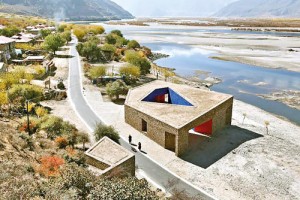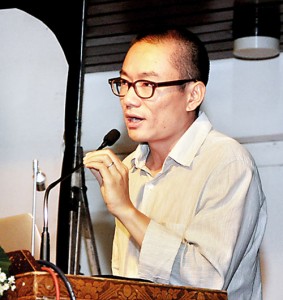Designing to blend with rural settings
Geoffrey Bawa is a familiar name for Yang Zhao. “I read a book which featured Bawa as a student,” the architect says barely five minutes into our interview. “So I began to try and learn everything I could about his work. He has definitely influenced career choices I’ve made.”

Made of stone and clay: Yang Zhao’s award-winning visitor centre in Tibet
This is why Zhao considers himself privileged to be sitting in what used to be Bawa’s residence with architect C. Anjalendran. Here to deliver the annual Bawa memorial lecture for the Geoffrey Bawa Trust on Bawa’s birth anniversary, Zhao is disarmingly down to earth. “It’s not something I ever think about that intensely,” he says of his chosen field. “I’m an architect. I design. It’s the process that I find very interesting.”
Zhao’s lecture was about learning through rural practices. As an architect practising in China, he has lived a significant proportion of his life in the city but says that somehow, he has never built anything in a city. “It’s funny, because I didn’t deliberately choose to practise in a rural setting at first,” he muses. “But somehow everything I’ve built has been in the suburbs or beyond.”
The 34-year-old grew up in Chongquin, where a combination of factors influenced him to pursue architecture. “Chongquin has a very dramatic landscape,” he explains. “So every structure has to be adapted to the environment and that fascinated me. Plus my father was a civil engineer and he would always make the architect’s job sound like a better prospect!”
Zhao studied at Beijing’s Tsinghua University, and then later at Harvard Graduate School of Design where he was influenced by a number of prolific architects and professors. In 2012, he was chosen as the first architectural protégé of the Rolex Mentor and Protégé Arts initiative. Under the mentorship of celebrated Japanese architect and Pritzker laureate Kazuyo Sejima, Zhao designed a Home-for-All centre for a fishing community affected by the 2011 earthquake and tsunami in Japan.
“It was an intense experience,” he says of the one-year programme. “Sejima was so generous with her time. All that was required was for her to act as my mentor for that year but she said that she couldn’t teach architecture by talking, so we chose a project and she would accompany me on visits to the community.” Zhao is a believer in conversation and democracy when it comes to his work. “With Sejima’s help in translating I spoke to the community about my ideas and received their input. I enjoy hearing from people about architecture and what it signifies to them as part of this society we live in.”
He is still trying to find his place in the discipline, but feels confident enough to venture forth as an architect who practises rurally. “When I first started designing and building, I was very unsatisfied,” he explains. “I was not comfortable and I disliked what I made.” A project in Tibet was

Yang Zhao delivering the Bawa lecture at the SLFI. Pix by Nilan Maligaspe
the catalyst for Zhao’s transformation. “I had the chance to use local materials, use local construction techniques and practise a different form of architecture to what I was used to,” he says. “It was very revealing for my practice.”
The geometrically shaped Niyang River Visitor Centre on the banks of the river at the gateway to Tibet’s Brahmaputra Canyon is built of stone and Aga clay. Stone grey on the outside, its inner walls are a vibrant blue and orange, reflective of Tibet’s colourful heritage. “It was a low cost, honest building. I knew this was what I wanted to do,” Zhao affirms. The structure won several awards for Zhao’s practice, including the Architecture in Stone Award 2011 from Marmomacc.
After Tibet he was offered a spot at Harvard which he happily embraced. “A good architect goes out into the world to learn internationally,” he believes. “Then he comes back and practises what he has learnt.” He continues to take on his projects as they come, but ensures that they are in line with what he’d like to be doing. Increasingly at odds with the nature of modern Chinese metropolitan architecture, he avoids taking on projects that he doesn’t believe in.
The architect enjoys what he does so much that his “tiny” practice, Zhaoyang Architects, is based in distinctly un-metropolitan Dali in central west Yunnan Province. The projects themselves are wonderfully diverse- from a village, to a rice field and even one site at the foot of a mountain. One project, the one in the middle of a rice field, is based on Bawa’s blueprint for his residence on Bagatalle Road, where this interview takes place.
“It’s very difficult to come to Sri Lanka and not be influenced by Bawa,” Zhao admits. Last year he visited and toured Bawa’s more famous works and intends to do the same this year. “In China we don’t have what your Sri Lankan architects have,” he says. “We don’t really have an architect that we can look up to. So I’m very happy to be under the umbrella, shall we say, of architects who are inspired by Bawa’s work.”
We return to his story about the rice field. “The gentleman who wanted the house designed was an artist and I immediately knew he would like the idea of the courtyard,” says Zhao. “I showed him Bawa’s blueprint and he liked it. The design we have now is quite similar. We have nine courtyards,” this he directs to Anjalendran who nods and laughs–we’re sitting in a house famed for its courtyards. Zhao grins. “But there is still some way to go.”


